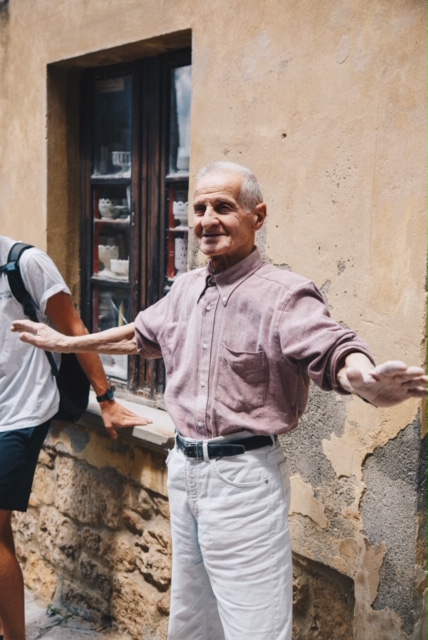Photo: Lauren Farkas
It was our first time to visit the Tuscan hilltop town of Volterra. We had become well familiar with other towns such as San Gimigniano, Sienna, and Monterigione, but we had somehow missed Volterra until we heard Rick Steves recommend it.
We found ourselves in front of a 2,500-year-old Etruscan gate and fascinated by a compelling story of saving the town from Nazi destruction during World War II, as told to us by our tour guide. But I had noticed something out of the corner of my eye: we had passed a small doorway on the steep street, out of which came a chink-chink-chink sound. In the window were a small number of alabaster sculptures and trinkets.
In addition to the distinction of being one of the earliest visitable towns from the ancient Etruscan civilization, Volterra is also a center of alabaster, a soft, light-colored, translucent stone mined in the area. Volterra is filled with shops containing beautiful alabaster creations, from simple items such as decorative wine stoppers and coasters to large, elaborate sculptures.
But this little workshop caught my eye for some reason, so I stopped to peek inside. There was an elderly gentleman working away at his bench, amidst a decades-old clutter of alabaster fragments and finished products. I had to meet this man. There were too many stories in that place for me to just walk on.
His name is Giuliano (pron. Juliano) and he is well into his 90’s. Two things about him struck me immediately: he looks much younger than his age, and his hands! His hands seemed huge in proportion to the rest of his slender, fit body, like MicheIangelo’s David’s — and they were as white as the alabaster he has been working most of his life. I asked if he minded my asking him some questions, and he welcomed me in with no questions asked. He has been working with alabaster for…wait for it…75 years. He was there during that Nazi threat, he was there during the Mussolini days, and he has been there since Tuscany became such a sought-after tourist destination.
A few weeks later, when my wife and I brought one of our tour groups to Volterra, I couldn’t wait to introduce them to Giugliano and hear some of his stories. I popped my head in to greet him. He was as cordial as ever, but it became quickly evident that he didn’t remember our conversation just weeks earlier. No matter, I thought — if he’s still willing to talk to us, we will still enjoy hearing him talk about his beloved home town and his craft. Since his shop is too small to fit more than three or four people, Giugliano came and stood in his doorway while I made my best attempt at interpreting his Italian into English for our group.
Since then, we have taken four more tour groups to Volterra, and you can bet we made it a point to stop and see Giugliano. And no, he doesn’t remember me from one time to the next. But he remains such a delightful person to talk to, and this way we can be sure that he doesn’t tire of answering our questions!
People like Giugliano are what makes travel such a deeply human experience. It’s one thing to admire the stunning Tuscan countryside and wander the quaint streets of towns like Volterra; it’s quite another to meet real people who are among the 12,000 who make their home there, to hear their stories and get a glimpse into how they see the world. You can be sure you’ll come away changed in some small way.

